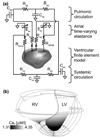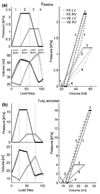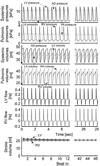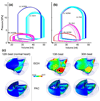Coupling of a 3D finite element model of cardiac ventricular mechanics to lumped systems models of the systemic and pulmonic circulation
- PMID: 17111210
- PMCID: PMC2872168
- DOI: 10.1007/s10439-006-9212-7
Coupling of a 3D finite element model of cardiac ventricular mechanics to lumped systems models of the systemic and pulmonic circulation
Abstract
In this study we present a novel, robust method to couple finite element (FE) models of cardiac mechanics to systems models of the circulation (CIRC), independent of cardiac phase. For each time step through a cardiac cycle, left and right ventricular pressures were calculated using ventricular compliances from the FE and CIRC models. These pressures served as boundary conditions in the FE and CIRC models. In succeeding steps, pressures were updated to minimize cavity volume error (FE minus CIRC volume) using Newton iterations. Coupling was achieved when a predefined criterion for the volume error was satisfied. Initial conditions for the multi-scale model were obtained by replacing the FE model with a varying elastance model, which takes into account direct ventricular interactions. Applying the coupling, a novel multi-scale model of the canine cardiovascular system was developed. Global hemodynamics and regional mechanics were calculated for multiple beats in two separate simulations with a left ventricular ischemic region and pulmonary artery constriction, respectively. After the interventions, global hemodynamics changed due to direct and indirect ventricular interactions, in agreement with previously published experimental results. The coupling method allows for simulations of multiple cardiac cycles for normal and pathophysiology, encompassing levels from cell to system.
Figures






References
-
- Bovendeerd PHM, Arts T, Delhaas T, Huyghe JM, Vancampen DH, Reneman RS. Regional wall mechanics in the ischemic left ventricle: Numerical modeling and dog experiments. Am. J. Physiol. Heart Circ. Physiol. 1996;39:H398–H410. - PubMed
-
- Bovendeerd PHM, Arts T, Huyghe JM, van Campen DH, Reneman RS. Dependence of local left-ventricular wall mechanics on myocardial fiber orientation – a model study. J. Biomech. 1992;25:1129–1140. - PubMed
-
- Brickner ME, Hillis LD. Congenital heart disease in adults – first of two parts. N. Engl. J. Med. 2000;342:256–263. - PubMed
-
- Burkhoff D, de Tombe PP, Hunter WC. Impact of ejection on magnitude and time course of ventricular pressure-generating capacity. Am. J. Physiol. Heart Circ. Physiol. 1993;265:H899–H909. - PubMed
-
- Carmeliet E. Cardiac ionic currents and acute ischemia: From channels to arrhythmias. Physiol. Rev. 1999;79:917–1017. - PubMed
Publication types
MeSH terms
Grants and funding
LinkOut - more resources
Full Text Sources
Other Literature Sources

